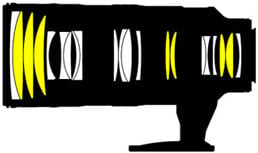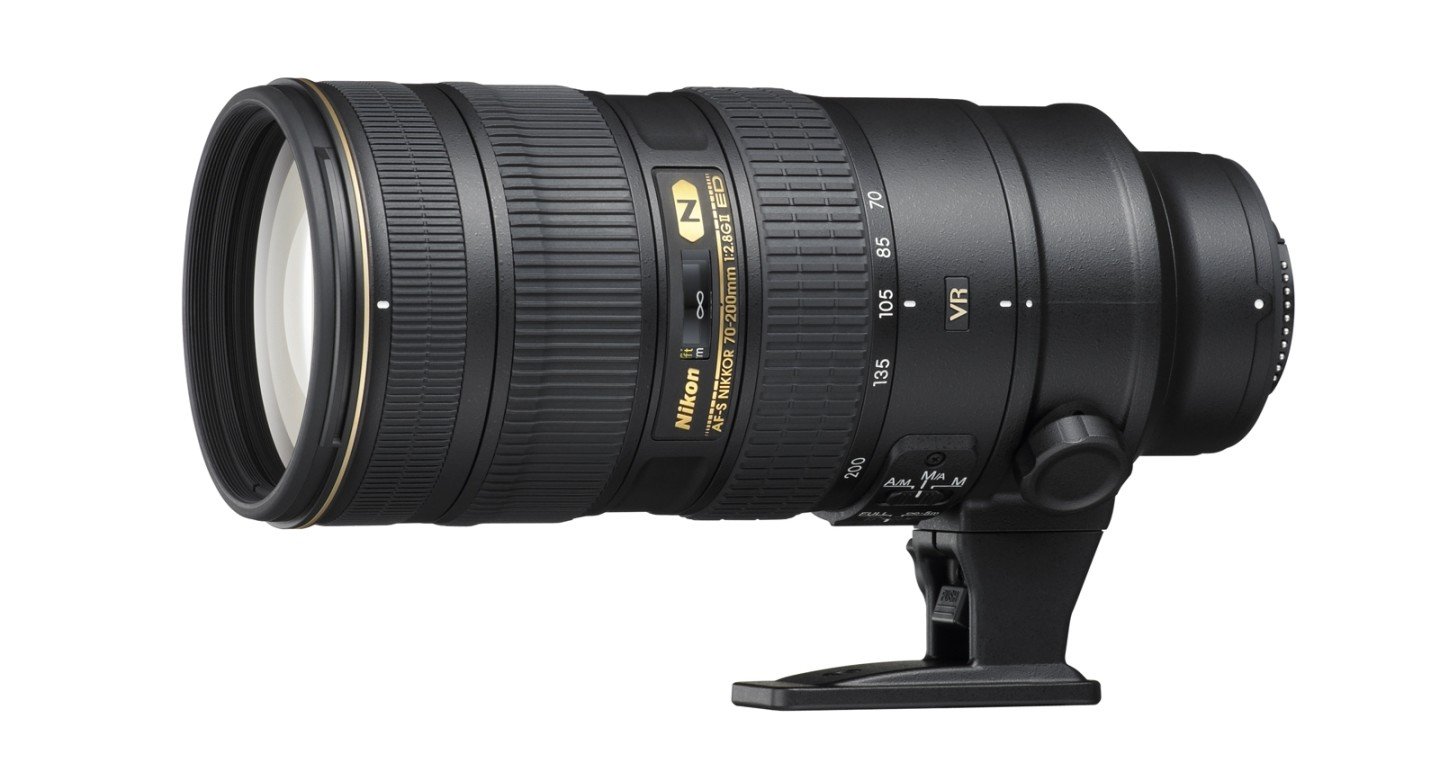Nikon 70-200mm f2.8G VR II review
-
-
Written by Thomas
Intro
The AF-S Nikkor 70-200mm f/2.8G ED VR II is Nikon’s professional f2.8 telephoto zoom. It covers a 2.9x zoom-range and was announced July 2009. It’s the successor to the AF-S Nikkor 70-200mm f/2.8G ED VR and has an improved optical design and better image stabilization. This speed and performance doesn’t come cheap, but to be fair it is similarly priced to the 70-200mm f2.8 pro options from Canon or Sony.
Complement this lens with a 24-70mm standard zoom and you can seamlessly cover a 8.3x zoom-range from fairly wide-angle to a decent tele with only two lenses. And while the 70-200mm f2.8 is corrected for full-frame FX format bodies, you could equally use it on a cropped-frame DX-body where it gives you an equivalent 105-300mm coverage plus future-proofing should you upgrade to an FX-body at a later date.
In my Nikon 70-200mm f/2.8 VR II review I’ll put this professional zoom to the test on a 36MP Nikon D800 body to see whether it’s a good match for the highest resolution full-frame DSLR. This review also comes after my in-depth Nikon 70-200mm f4 review, so I’ll be able to tell you the pros and cons of both models to help you choose which will be the best telephoto zoom for you.
Facts from the catalog
As usual I’ll have a look at the technical data first. I’ve rated the features with a [+] (or [++]), when it’s better than average or even state of the art, a [0] if it’s standard or just average, and [-] if there’s a disadvantage.
 |
Size (diam. x length): 87 x 206 mm (3.4 x 8.1 in.). Size is roughly the same as the competition. Only its smaller brother, the Nikon 70-200/4.0G VR, is a bit smaller. The lens does not change length during zooming or focusing. [0]
Weight: 1,540 g (3.4 lb.). Only 110g heavier than the Sigma 70-200/2.8 OS. Mounted on a full frame body your shoulders will definitely feel the combined 2.4kg. [0]
Optics: 21 elements in 16 groups. 32 air/glass-surfaces provide a lot of opportunities for flares and ghosts. Nikon has applied their special Nano Crystal Coat on some elements. We’ll see how this works out in practice. The cross-section shows a lot of special elements: seven extra-low dispersion elements. [0]
Closest focus distance/max. magnification: 1.4 m (4.6 ft.) / 1:8.3. In my test I was able to go down to 1: 7.9. This meager magnification also means that the effective focal length shrinks some 30% when focusing close. Similar to what the Sigma achieves. [0]
Filter-thread: 77mm = standard with most pro-lenses [+]
IS: Yes, VR 2nd generation = great! At focal lengths beyond 100mm and with today’s high resolution sensors image stabilization is an indispensable feature. But the competition has finally caught up[+]
AF: AF-S with SWM (silent wave motor), so it does work on D60/3×00/5×00-bodies, manual-focus override by turning the focus ring [+]
Covers full frame/FX or smaller = very good [+]
Price: around 1800 EUR new (incl. 19% VAT) = expensive. The alternative from Sigma is 50% cheaper. See above for the latest pricing. [-]
Comes with a very nice semi-soft lens-case that is well padded, the lens-shade is included, reversible for transport, and has an interlock to prevent accidental loss, and the lens-caps are standard Nikon’s. [+]
Distance information is relayed to the camera, so the Nikon body can do all the advanced exposure-related stuff with this lens. But this is true for all alternatives too. [+]
Aperture ring = no, just like all competitors. [0]
Sealing: yes! A rubber grommet at the lens-mount. [+]
The score in the “features-department” is 1[-]/5[0]/7[+]. The minus-point being the steep price. But the price is only high compared to third party alternatives. If you compare the lens to offerings from Sony and Canon you could as well say that the Nikon is comparatively priced.
Motivation
:
A stabilized 2.9x zoom with a focal range of 70-200mm is an excellent complement to a 24-70mm standard zoom on an FX body. The Nikon has a constant f2.8 aperture that is sought after by photographers who need to capture fast moving action or isolate the subject with a shallow depth of field. Its zoom range is flexible enough to capture most action that is a little further away: A person can be captured full-hight in landscape orientation from around 17m distance on a full-frame body (or from 25m distance on a DX-body).
Alternatives
:
– Sigma’s AF 70-200mm 2.8 EX DG APO HSM OS is the cheapest way (around 950 EUR) to get a stabilized 70-200mm f2.8 zoom. See my Sigma 70-200 f2.8 OS review.
– Nikon’s AF-S VR 70-200mm 4.0G ED VR is the cheaper and much lighter package than the premium f2.8 version. You give up one stop of maximum aperture but that makes it also lighter on your wallet (around 1200 EUR). See my Nikon 70-200 f4 VR review.
– The not yet released Tamron SP AF 70-200mm 2.8 Di VC USD: The cheapest listing of around 1500 EUR certainly is not a real street price yet.
Focus, build quality, and image stabilization
Focus accuracy and repeatability is critical to consistently produce sharp shots. Repeatability (the accuracy of focus on the same subject after repeated focus-acquisition) of this lens is very good with no outliers over a series of 40 shots. And there is no performance variation whether the lens focuses coming from infinity or from minimum focus distance. The lens focuses pretty fast: around 0.6 sec from infinity to 1.4m, which is a good value.
The focus ring has no slack/play between its movement and the focus-action and a throw of around 130 degrees, which makes accurate focus wide open up to 150mm easy. The focus ring is easy to grip and movement is very smooth. And while zoom-action is pretty smooth too you can feel the heft of the glass that is being moved inside. AF-operation is audible from the outside, and if you record video with the built-in microphone every focus-movement starts and stops with an audible “clack” and the AF-drive can clearly be heard in-between. Especially in the low-speed (movie) live-view AF mode when focus is relatively close to the target a humming noise is recorded. The VR-system is quiet on the outside but video records some background noise from it that registers as one to two bars on the sound level meter and you may also record the occasional clack when the system hits its limits – albeit not as harsh as with the AF. Shaking the lens produces some noises.
In general the impression of build quality is that of a pro-level lens: A high quality metal/plastic construction combined with a weather sealed metal lens-mount, and nine rounded aperture blades.
To test the effectiveness of the image stabilization I did a series of over 120 test-shots hand-held at 200mm with VR=ON at 1/25 sec and with VR=OFF at 1/200 sec. Rating the sharpness of those images at 100% magnification on a scale from 0 to 5 the sample of images with VR=ON looked a little worse on average than the sample with VR=OFF which had the benefit of a 8x faster shutter-speed. So VR on this lens gives you an advantage of around 2-3 stops. What irritated me with the lens’ image stabilization was a tendency to assume that I was panning when I started the VR with my shaky hands: The lens simply left one axis unstabilized until I was holding it stable enough to not be interpreted as tracking a moving target. Perhaps a case for the service?





